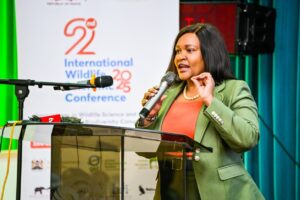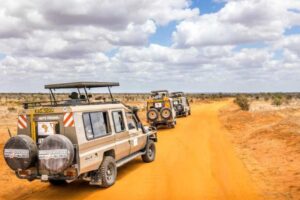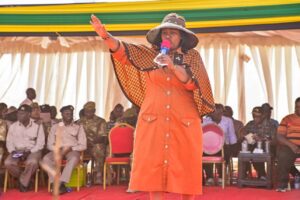“On the 27th March 2020 we announced a nationwide dusk-to-dawn curfew. Then on the 5th of April, 2020 we augmented it by announcing the Cessation of Movement into and out of a number of areas. Later on, more measures were announced to contain the havoc visited upon us by the COVID-19 pandemic.
Given this trajectory and the fact that this crisis requires a long term strategy, I took time to reflect on “…What must be Done”. If we lift the cessation of the movement ban, how will this help us fight the Pandemic? And if we do NOT, how will the ban affect our economy, especially, the micro-business enterprises and those who derive their livelihoods from them?
To answer these questions, I turned to our Brain Trust, made up of the finest doctors, research scientists, and public practitioners for counsel. And I must admit that opinion was divided on how we are to advance against this VIRUS.
Some, including myself, wanted to open up NOW. That was, and is still my desire. I want to OPEN UP at the earliest opportunity and get the economy going. More so, as Kenya was ranked the third largest economy in Sub-Sahara Africa this week.
Others held a contrary opinion. They borrowed from history, scientific models and current experiences the world-over to argue against opening up.
With these two viewpoints on the table, I was not dealing with a RIGHT and a WRONG: I was caught in-between two RIGHTS. Those who want to open up are RIGHT, and those opposed to opening up are also RIGHT. And this clash of two RIGHTS placed me on the ‘Horns of a DILEMMA’.
In the absence of a scientific consensus amongst experts in the medical, research and public sectors, I asked for scenarios. I wanted to know the worst-case scenario and the best options available for us to contain the spread of the disease without affecting the economy irreversibly. And I wanted these scenarios built around raw facts because we have decided to combat this pandemic in an open and transparent manner.
Fellow Kenyans,
Truth be told, if we had not taken the STRINGENT measures we did in March 2020, the rate of infections would have peaked to 800,000 people by July 30th 2020. And if one infected person has the potential to infect two people, this number would have hit 2.4 million people in 21 days. By the end of August, 75,000 Kenyans would have died from this virus. But because of the early interventions we took, we have recorded only 2,600 infections and 83 deaths
If this is the worst case scenario, I wanted to know what the other scenarios looked like. If we put in place all the necessary interventions and relaxed them by only 20%, what would this look like?
According to the experts standing behind me, relaxing the interventions by 20% would lead to 200,000 infections and 30,000 deaths by December 2020.
Further, if we relax the interventions by 40%, the infections will peak in November 2020 with 300,000 infected and 40,000 deaths. And if we relax them by 60%, the pandemic will peak in October with 450,000 infections and 45,000 deaths.
Although these projections are generated by a model, there is hard evidence suggesting that countries which opened up without proper protocols also experienced serious waves of infections. Spikes of infections were for instance experienced after re-opening religious gatherings in South Korea, Pakistan and Malaysia.
If this is our new reality, and we face the dilemma of easing restrictions or continuing with them, what must we do as a country? What is the irreducible minimum for re-opening the country? What is the threshold below which we cannot go?
According to the professionals standing behind me, the irreducible minimum for lifting the restrictions has three thresholds. One, to open up, the infections must have been contained and headed downwards.
Two, our health care system must be prepared sufficiently to take on a surge in infections. It must not be overwhelmed at any one point during the pandemic. Access to testing, isolation and quarantine must be a bare minimum. Three, capacity for surveillance and contact tracing must be in place.
The question we must ponder is whether we have met this threshold in order to lift the restrictions. Have the cases of infections taken a down turn, for instance? And the answer is NO. Nairobi and Mombasa are taking the lead with new infections.
Have we met the second minimum of a prepared health system with isolation facilities? I will answer that question by giving you two examples. Siaya County has a ten (10) bed isolation facility and they have already admitted nine (9) Covid-19 patients from only one incident.
Similarly, Busia County has a thirty-four (34) bed isolation facility. And by two days ago, it was full.
If there is a surge in infections in these two counties, the health care system will be overwhelmed. The hard question to pose here, therefore, is whether Kenyans are prepared to nurse COVID-19 patients in their homes if our health care system cannot handle the numbers.
Are they prepared to expose their children and the elderly to COVID-19 patients in the close proximity of home?
And yes, we have disbursed Ksh 5 billion to the counties to increase their health care capacity in view of this pandemic. But to build the necessary health infrastructure for such undertakings requires time. We must get ahead of this pandemic by creating lead time.
Therefore, while I consider the possibility of de-escalating the containment measures in place and conscious that Health is a shared function – between the National and County Governments, I, have convened an Extra-Ordinary session of the National and County Government Co-ordinating Summit on Wednesday the 10th day of June 2020, to consider the following salient matters:
First, to review the effectiveness of the containment measures we have so far rolled out to break the chain of transmission of the Coronavirus Disease;
Second, to secure the undertaking of every County Government to deliver isolation facilities with at least 300 bed-capacity.
And thirdly, within 14 days, to develop time-bound protocols for progressive re-opening of the economy.
Fellow Kenyans,
I have applied my mind to the different scenarios presented by our experts. And I have reconciled myself to the fact that to ‘open’ or not to ‘open’ up is not a dilemma between a right and a wrong. It is a dilemma between two rights.
Because of this, and fully cognizant of the irreducible minimum given by our experts, and in keeping with the advice of the National Security Council; I hereby DIRECT and ORDER as follows:
That the cessation of movement into and out of the Eastleigh Area of Nairobi and the specific limitations in force with respect to the Mombasa Old Town Area that is currently in force, shall lapse at 4:00 a.m. on 7th of June, 2020.
That in view of the successful containment of the disease in the Counties of Kilifi and Kwale, the cessation of movement into and out of the two Counties that is currently in force, shall lapse at 4:00 a.m. on 7th of June, 2020.
That following stakeholder’s consultations in the education sector – the Ministry of Education jointly with the Ministry of Health issues and publicizes guidelines on a gradual and progressive return to normalcy in the education sector by the Third Term, from 1st September, 2020. Further, that the ministry announces the new school calendar by mid -August.
That following consultations with interfaith and religious organizations, the Ministries of Interior and Health within seven days, constitutes an Inter-Faith Council, to work out modalities and protocols of re-opening of the places of worship.
That in the meantime, the ban on all forms of gatherings, including but not limited to political gatherings, social gatherings, including bars be and is hereby extended for a further 30 days.
That due to the evolving nature of the disease globally, international travel restrictions are hereby extended. In the meantime, the Ministry of Transport is directed within seven days from the date hereof, to engage all Key Stakeholders and develop protocols to guide resumption of local air travel.
That due to the increase in patterns of infections, the cessation of movement into and out of the Nairobi Metropolitan Area, Mombasa and Mandera be further extended by 30 days.
To accord all Kenyans the opportunity to enjoy a full-day’s work, the nationwide dusk-to-dawn curfew currently in force until today the 6th June, 2020, be and is extended for a further 30 days. However, the commencement time for the same is varied from 7:00 p.m. to 9:00 p.m.; with the end time for the same being varied from 5:00 a.m. to 4:00 a.m. Therefore, effective 7th June, 2020 the national wide dusk-to-dawn Curfew will run from 9:00 O’clock in the evening to 4:00 O’clock in the morning.
Fellow Kenyans,
Recognizing that the negative impact of COVID-19 is not limited to health care, my Administration has made targeted interventions to protect our economy.
At the outset of this pandemic, my administration injected KSh. 216 Billion back into the Economy through tax refunds, rebates and waivers. In the second phase we have further rolled-out Ksh. 53.7 Billion under the 8-point stimulus package to reinvigorate our Economy.
And on Madaraka day, I announced that a total of Ksh 2 billion would be injected into the hotel industry to cushion them from the effects of this pandemic. Modalities of how these resources will be shared are to be released next week.
Finally, I wish to assure each and every Kenyan that I shall do all that is necessary to limit the negative effects of COVID-19 on our People, Economy and Way of Life. Rest assured, my Administration will restore our lost livelihoods, our lost opportunities and our lost wealth.
I call on all Kenyans, particularly landlords and employers, to put people before profits during these testing times.
Permit me to close by saying that this Disease is beatable if we work together; listen to and apply the regulations, guidelines and protocols issued by the Ministry of Health; and keep our eyes on slaying the enemy.
Thank You and God Bless You; and God Bless Kenya.












